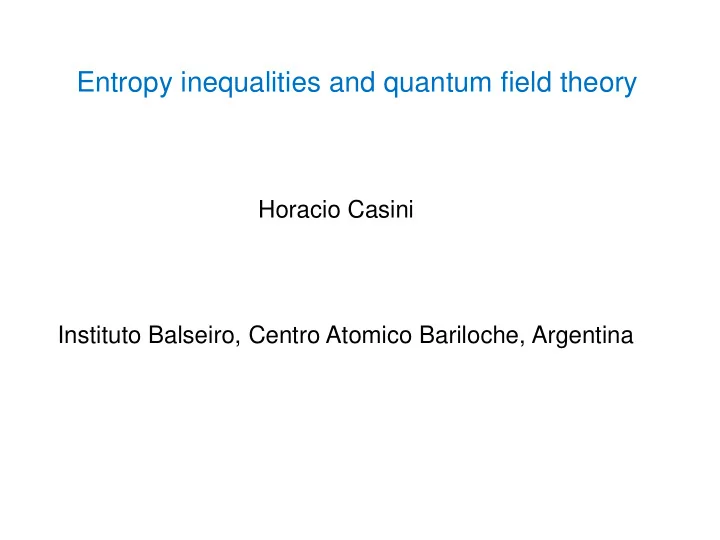

Entropy inequalities and quantum field theory Horacio Casini Instituto Balseiro, Centro Atomico Bariloche, Argentina
Entanglement entropy Area law : « » C.Callan, F. Wilczek, hep-th/9401072
Entropy inequalities One state two regions Two states, one region Positivity and monotonicity Strong subadditivity of relative entropy C-theorems in Entropy bounds d=2 and d=3 Bekenstein bound H.C, M. Huerta (2004,2012) Bousso bound (weak gravity). R. Bousso, H.C., Z. Fisher, J. Maldacena (2014) Generalized second law (weak gravity) A. Wall (2011)
Bekenstein (1981) Inicial entropy : Final entropy: Einstein equations + generalized second law: Bekenstein universal bound on entropy S, E, R It is independent of G Does black hole thermodynamics tell something new about flat space physics?
Some puzzles: What is the meaning of R? Does it imply boundary conditions? Was not the localized entropy divergent? Species problem: What if we increase the number of particle species? (S increases, E is fixed) The local energy can be negative while entropy is positive…
Marolf, Minic, Ross 2004, Quantum Bekenstein bound Sorkin 2002, H.C. 2008 Entanglement entropy in vacuum! Hence, the left hand side of the inequality is The right hand side is more precisely x Then the bound reads The near horizon limit of a large BH
Quantum Bekenstein bound This clarifies all the puzzles: What is the meaning of R? The product ER is well defined Does it imply boundary conditions? NO Was not the localized entropy divergent? The difference is not! What if we increase the number of particle species? The entropy difference saturates The local energy can be negative while entropy is positive… The entropy difference can be negative
Proof of quantum Bekenstein bound Preestablished relation between energy and entropy: Vacuum state in half space determined by the energy density operator for all quantum field theories. time Bisognano Wichmann (1975). Unruh (1976): x Relative entropy between two states is positive Conclusion: quantum Bekenstein bound holds. It is saved by quantum effects. It is consistent with black hole thermodynamics, but follows already from the combination of special relativity and quantum mechanics. Then it is not a new constraint coming from black hole physics.
(entropic) c-theorems in 1+1 and 2+1 dimensions Teorema C There is a dimensionless function C on the space of theories which decreases along the renormalization group trajectories from the UV fixed point to the IR fixed point and has finite values at the fixed points. General constraint for the renormalization group. Ordering of the fixed points Proofs not using entanglement Conjectured in d=2+1: entropy: Holographic C theorems. d=1+1: A.B.Zamolodchikov (1986) R.C.Myers and A.Sinha (2010). d=3+1: Z. Komargodski, F theorem, D.Jafferis, I.Klebanov, A Schwimmer (2011) S.Pufu, B.Safdi (2011).
Strong subadditivity + Causality + Lorentz invariace Strong subadditivity Causality S is a function of causal regions, or «diamonds»
1+1 dimensions H.C., M. Huerta, 2004 C(r) is dimensionless, well defined, and decresing. At the fixed point (scale invariant theory): C(r)=c/3 The c-charge is proportional to Virasoro central charge at fixed points in 1+1. This is the same result as Zamolodchikov’s but the function C is very different outside the fixed points
2+1 dimensions H.C., M. Huerta, 2012 Many circles to obtain circles as a limit. Circles at null cone to avoid divergent logarithmic Previously conjectured by terms due to corners H. Liu, M. Mezei, 2012 At fixed points Is the constant term in the entropy of a circle = free energy F of the conformal theory on a 3-sphere.
There is a c-theorem in 2+1 dimension for relativistic theories (also called F-theorem). No proof has been found yet for d=3 that does not use entanglement entropy. Is C a measure of «number of field degrees of freedom»? C is not an anomaly in d=3. It is a small universal term in a divergent entanglement entropy. It is very different from a «number of field degrees of freedom»: Topological theories with no local degree of freedom can have a large C (topological entanglement entropy)! C does measure some form of entanglement that is lost under renormalization, but what kind of entanglement? Is there some loss of information interpretation? Even if the theorem applies to an entropic quantity, there is no known interpretation in terms of some loss of information. Understanding this could tell us whether there is a version of the theorem that extends beyond relativistic theories. More inequalities seem to be needed for an entropic c-theorem in higher dimensions.
Entanglement entropy is a funcion of the global state and the algebras of operators associated to causal regions. It fits naturally within the algebraic approach to QFT as a kind of «statistical correlator» which exists for any theory. Renyi twisting operators are surface operators also attached to the algebras. Does entanglement entropy of vacuum uniquely determine the theory? If yes, likely there are infinitely many other inequalities beyond strong subadditivity to reconstruct the Hilbert space.
Recommend
More recommend